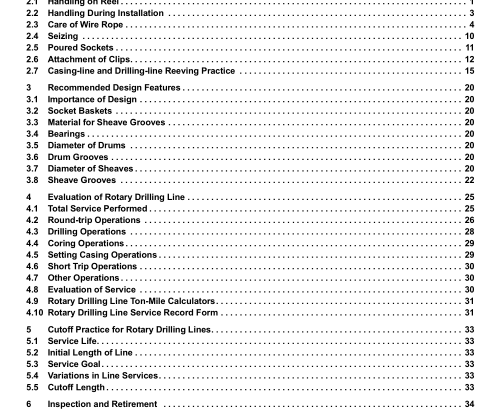API 9B:2020 pdf free download.Application, Care, and Use of Wire Rope for Oil Field Service
2.3.10 Wire Breakage from
Martensite in Drilling Lines Care should be taken to maintain proper winding of rotary drilling lines on the drawworks drum in order to avoid excessive friction which may result in the formation of martensite. Martensite may be formed by excessive friction at kick over points on the drum, in worn grooves of sheaves, slippage in sheaves, or friction resulting from rubbing against a derrick member. A line guide should be employed between the drum and the fast line sheave to reduce vibration and keep the drilling line from rubbing against the derrick. On rigs with motion compensations, the high line speeds and sudden direction reversals can cause rope slippage in sheave grooves which can result in martensite formation.
NOTE 1 Martensite is a hard, nonductile micro constituent that is formed when steel is heated above its critical temperature and cooled rapidly. In the case of steel of the composition conventionally used for rope wire, martensite can be formed if the wire surface is heated to a temperature near or somewhat excess of 1400 °F (760 °C), and then cooled at a comparatively rapid rate. The presence of a martensite film at the surface of the outer wires of a rope that has been in service is evidence that sufficient frictional heat has been generated on the crown of the rope wires to momentarily raise the temperature of the wire surface to a point above the critical temperature range of the steel. The heated surface is then rapidly cooled by the adjacent cold metal within the wire and the rope structure and effective quenching results.
NOTE 2 Detail A of Figure 4 shows a rope, which has developed fatigue fractures at the crown in the outer wires, and Detail B of Figure 4 shows a photomicrograph (100× magnification) of a specimen cut from the crown of one of these outer wires. This photomicrograph clearly shows the depth of the martensitic layer and the cracks produced by the inability of the martensite to withstand the normal flexing of the rope. The initial cracks in the martensitic layer cause the failures appearing on the crown of the outer wires of this rope. The result is a disappointing service life for the rope. Most outer wire failures may be attributed to the presence of martensite, if this hard constituent is known to have been formed.
2.3.11 Worn Sheave and DrumGrooves Worn sheave and drum grooves cause excessive wear on the rope.
2.3.12 Sheave Alignment
All sheaves should be in proper alignment. The fast sheave should line up with the center of the hoisting drum. Proper alignment is achieved when fleet angles between sheaves and the ends of the wire rope drums are between 0.5° and 1.5° (see 2.7.1).
2.3.13 Sheave Grooves From the standpoint of wire rope life, the condition and contour of sheave grooves are important and should be checked periodically. The sheave groove should have a radius not less than that in Table 7; otherwise, a reduction in rope life can be expected. Reconditioned sheave grooves should conform to the recommended radii for new sheaves as given in Table 7. Each operator should establish the most economical point at which sheaves should be re- grooved or replaced by considering the loss in rope life which will result from worn sheaves as compared to the cost involved. Consult the sheave manufacturer for guidance on the re-grooving of their sheaves.
2.3.14 Installation ofNew Rope When a new rope is to be installed on used sheaves, it is particularly important that the sheave grooves be checked as recommended in 2.3.13.API 9B pdf download.API 9B:2020 pdf free download
